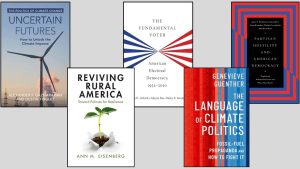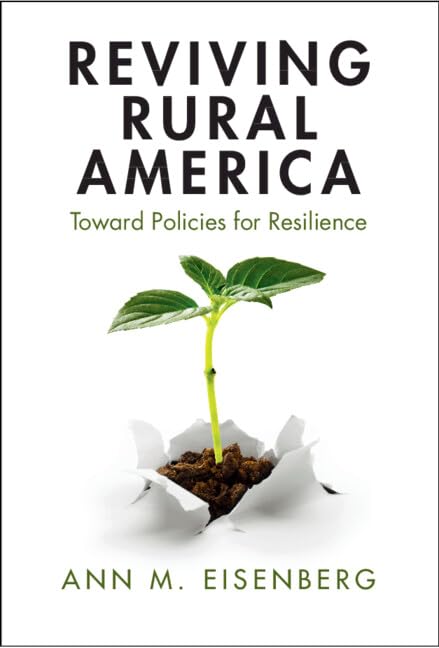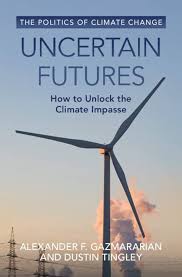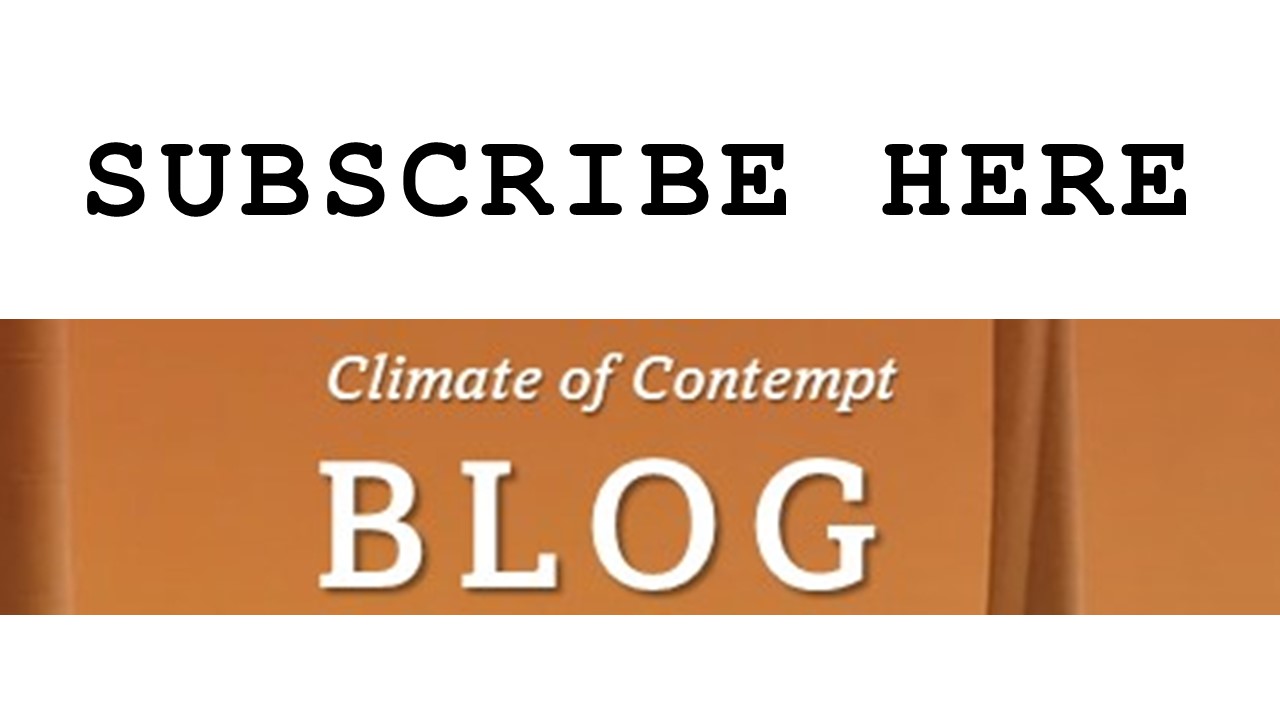
This is the second in a series of posts discussing new books that address what we know, and don’t know, about today’s energy and climate politics. You can find the explanatory introduction to this series here. Today we focus on rural resistance to the energy transition; tomorrow we look at why voters vote in ways that reward extremism and bitterness, even if they don’t like it when their politicians exhibit those qualities.
Focus on Rural Resistance
- Alexander F. Gazmararian & Dustin Tingley, Uncertain Futures: How to Unlock the Climate Impasse (Cambridge U Press, 2023).
- Ann M. Eisenberg, Reviving Rural America: Toward Policies for Resilience (Cambridge U Press, 2024).
If you are looking for a deep dive into the question of why local communities (particularly rural communities) resist the energy transition, these two books are for you. Uncertain Futures is written by two political scientists; the author of Reviving Rural America is a legal scholar who focuses on rural issues, including rural energy transition issues. Both analyses go to the source: people in rural communities. Gazmararian & Tingley use structured surveys and interviews to draw their conclusions, while Eisenberg’s book mixes reviews of deep case studies into her personal and professional journey as an advocate for rural people.
The Analyses
Both books explore rural communities’ sense of being looked down upon and left behind by urbanites, as well as their deep skepticism of government. Like the “deliverism” literature I discuss (critically) in Climate of Contempt, both books seem to accept the premise that economic self-interest lies at the root of rural political attitudes, and so both discuss ways to make a greener future worth the while (economically) of the local communities that resist it. But beyond these basic commonalities, the two analyses differ from one another in significant ways.
Eisenberg’s is a broad narrative of power and neglect that leans on ideas from sociology and critical legal studies. It is organized around a series of “myths,” belief in which Eisenberg assigns to urban political elites – things like “all rural people are farmers,” “rural people are unsophisticated,” etc.. She seeks to refute accounts like J.D. Vance’s Hillbilly Elegy that blame rural people for rural struggles. At the same time she rejects terms like “rural decline” that imply that no one is to blame for the plight of rural communities.[i] Rather, she assigns blame to (a) what she calls “urbanormative” thinking by policymaking elites, and (b) the hegemonic influence of public choice economics – what Eisenberg calls “market supremacy” — over U.S. policymaking in recent decades.
The book contains a number of compelling explanations of exactly why existing institutions — such as those aimed at helping communities deal with housing and energy infrastructure issues — don’t fit very well in distressed rural areas. In the end, Eisenberg argues that urbanites’ disregard of rural people is the root of the problem. (I share her intuition that for urban elites rural communities are often out of sight and therefore out of mind.) Rural economies are worth preserving, says Eisenberg, because urbanites need the resources and amenities that come from rural communities. Her prescription is a long-term national program to rebuild physical and social infrastructure in rural areas, though it is one that is longer on objectives than it is on the “how-to” specifics.
But perhaps that is where Uncertain Futures comes in. Eschewing the question of blame that seems central to Eisenberg’s analysis, Gazmararian and Tingley focus on how rural people think about regulation and energy investment in their communities. They see local resistance to new green energy infrastructure as an “impasse” that is slowing the energy transition, one that must be overcome.
Gazmararian and Tingley are skeptical that top-down solutions can break the impasse:
People fall back on simple answers. One view is that fossil fuel lobbyists have bought off politicians and misinformed the public’s beliefs about climate science. Another explanation is that partisan polarization is so great that meaningful political reforms cannot pass. … Remove money from politics? Good luck.[ii]
Rather, they see local acceptance of the energy transition as the key to unlocking the impasse. But are skeptical of the kind of dialogue I suggest in my book: “Change the minds of a climate skeptic with scientific facts? Not in this lifetime.”[iii] Instead, Uncertain Futures focuses on “what’s in it for me” bargaining, arguing that local acceptance of energy infrastructure requires credible government commitments to making the transition economically worthwhile for locals.
The authors identify various policy instruments and regulatory devices that governments can use to credibly commit to helping local communities share in the benefits of the energy transition. And their analyses of data from their own structured interviews and surveys suggest that those policy devices may indeed move those locals toward greater support for (and acceptance of) the energy transition, or at least greater acceptance of clean energy projects in their towns.
What These Books Say About How Energy Politics Works
Both of these books assume that individuals’ economic circumstances drive their political attitudes. Gazamararian and Tingley’s analysis is more voter-centric, while Eisenberg’s is more elite-centric. Gazamararian and Tingley believe that changing local hearts and minds must precede policy change, not the other way around. And implicit in their prescription is the notion that self-interest trumps ideology or partisanship. And Gazmararian and Tingley seem optimistic that credible commitments can overcome local skepticism. Consequently, their narrative reflects much less cynicism about power politics than Eisenberg’s.
Eisenberg’s is a more top-down prescription. Because she sees the (unacceptable) status quo as the “policy driven manifestation of … collective values” that disregard rural interests,[iv] urban elites must change before rural fortunes can change. In her telling, locals’ “company town-like” dependence on one big employer constitutes a massive barrier to changing local attitudes, and just another of the many ways economic elites exploit the economically weak.
Gazmararian and Tingley are more circumspect than Eisenberg about their diagnoses, adhering as they do to social science norms. Eisenberg’s analysis could have benefited from either more data or more circumspection in places. For example, she stresses urbanites’ lack of regard for rural struggles early and often throughout the book, but that assertion is mostly supported by anecdotes rather than data. And her narratives tend to slide almost imperceptibly between understanding the subjective lived experience of marginalized rural people, on the one hand, and accepting their inferences about causation — about who is to blame for their struggles — on the other.
And both books sometimes shade hard truths here and there.
Some of Eisenberg’s best insights are partly obscured by her attempts to reconcile progressive power narratives that are in tension with one another. For example, her exploration of rural peoples’ perceptions of the regulatory state contains an excellent discussion of when people attach legitimacy to policy decisions, noting that people regard policy choices as less legitimate when they look like an attempt to give one subgroup a leg up over another. But for some reason she ignores this issue in her discussion of Arlie Hochschild’s seminal study, Strangers In Their Own Land, even one of Hochschild’s central findings is that rural white males see gains made by minorities and women as coming at their expense.
In Uncertain Futures, Gazmararian and Tingley’s sort of tiptoe around the fact that local jobs in the fossil fuel industry (e.g., in a mine, or a coal-fired power plant) are better-paying and more permanent than the local jobs associated with wind farms or solar farms. They discuss how locals feel about different types of energy jobs, acknowledging the perception moreso than the fact.
Conclusion
But there are enough valuable insights in both books to relegate these objections to mere quibbles. Both of these books shine a diagnostic light on conservative rural politics and what it means for the energy transition. Both give readers a much richer understanding of rural communities and their relationship to the regulatory state and the energy transition. And the appeal of Trumpism to rural conservatives hangs like a cloud over both analyses.
Both books challenge my skepticism about deliverism; and both seem optimistic that it can change voters’ minds, and ultimately energy policies or outcomes. Neither book has much to say about the role of the modern information environment with sustaining opposition to the transition, suggesting that these authors don’t regard it as a central political force (the way I do).
The next few years are shaping up as a test of the relative influence of deliverism vs. media-driven partisanship. Rural communities are already suffering greatly under the Trump tariffs and the GOP’s removal of some of the economic benefits conferred on local communities by Congress (under the Inflation Reduction Act and Bipartisan Infrastructure Law). The election of 2026 will tell us whether that economic pain can overcome the narratives that frame all news in ways that build party loyalty. In the meantime we can read the tea leaves. For example, how many Republicans representing rural communities will stand up against the Trump Administration initiatives that hurt rural communities? How many will oppose repeal of the Inflation Reduction Act when it comes before Congress? Will Congress repeal the Trump tariffs? We shall see.
All that said, both of these books offer valuable insights into the logic and sincerity of local opposition to the energy transition, and to the energy investments it requires. And both put the lie to the idea that the tradeoffs we must make to get to a much lower carbon economy are easy ones.
Tomorrow: two important books explaining partisan hostility. — David Spence
———————–
[i] Reviving Rural America, p. 22.
[ii] Uncertain Futures, p. 7.
[iii] Ibid.
[iv] Reviving Rural America, p. 17.



